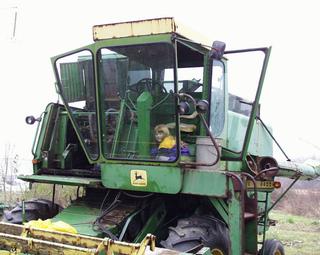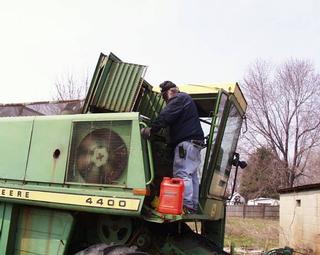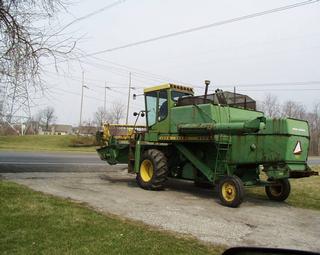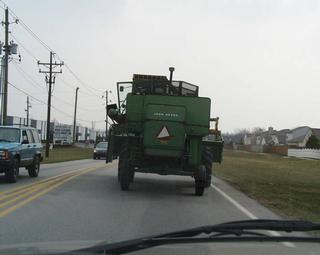by The Red, John Fritz From December 2, 1999 to March 31, 2001, I continued to work on the combine off and on. I was very encouraged from all the great replies to my first article. The tractor fund was low on money during this period of time so I did not accomplish as much as I had hoped for. The new windshield was installed on a snowy day, December 13, 1999. Now the combine was buttoned up for the winter. I thought about placing a tarp over the cab and the grain tank, but I was afraid it would be stolen. Indianapolis was blessed with a mild winter. I returned to the combine in early February 2000. Fortunately nobody had bothered the machine during the winter. My goal today was to start it and try to find the major hydraulic leak near the front axle. I filled the hydraulic reservoir and mounted the battery. After spraying some starter fluid in the throat of the carburetor, I cranked the engine and it fired within 3 revolutions. After about a minute, I opened up the choke and the engine smoothed out. I raised the grain table and hopped down to determine what was leaking. I discovered that the hydraulic line on top of the front axle, which connects to the lifting cylinders, was the culprit. I lowered the grain table and let the engine run for 20 minutes. After shutting the machine down, I grabbed some wrenches and crawled under the feeder house and removed the hydraulic line and two hoses that connected to the two lift cylinders. I took the split hydraulic line out to NAPA and they manufactured a new hose to replace the line. A few days later I returned to the combine and re-installed the hydraulic hoses. After I filled the hydraulic reservoir, I fired up the engine. I raised the grain table and hopped down to look for leaks. Mission success with no leaking around the axle! However I noticed a slow hydraulic leak had developed under the cab. I would have to address that problem before I moved the combine off the lot. I drove the combine up and down the lot checking out 1st. gear, 2nd. and reverse. Other than the shift lever being stiff, the combine was moving fine. I Backed one more time and started forward. I wanted to see if the variable speed drive was working. In the process of moving forward the engine sputtered and died. I shot some starter fluid in the carburetor throat Started it up and it was fine. When I started moving it again it sputtered and died a second time. I hopped down and looked at the electric fuel pump and the strainer assembly. The bowl was packed with rust! There had been several discussions on the YT Farmall forum about rust in the gas tank and how it could clog a strainer assembly. I was running out of daylight so I called it a day. I returned to the combine about a week later. I drained what gas was in the tank and removed the fuel strainer assembly. The filler neck on the strainer was packed full of rust. I grabbed a bunch of wrenches and removed the gas tank. The tank removal took over an hour. It was bolted in every direction imaginable! After I got the tank home, I removed the fuel gauge sensor and looked inside with a small flashlight. The tank was very rusty. I called my NAPA friends and they highly recommended Plainfield Radiator Service in Plainfield, Indiana. After getting directions, I took the radiator to their shop. About two weeks later, I picked up the gas tank. They had boiled the tank twice and coated the inside with a red sealer. I thought they did an excellent job for $217. I brought it home and gave the outside of the tank two coats of paint. I let the paint cure for a few days. Late in March I returned to the combine and installed the tank. I had forgotten how heavy it was! It took me two hours to get it up on the bottom brackets and bolt it to the combine. I filled the tank with 5 gallons of gas and started the combine up. I did some more driving up and down the lot. The engine was running well and the power steering was finally working well. I think it took a few hours of engine operation for all the air bubbles to work out of the hydraulic system. After driving it for about 15 minutes, I hopped down and started looking for the leak under the cab. There was a rag stuffed between the two power steering hydraulic lines under the cab floor. When I removed the rag, the leaking intensified. I had another split steel hydraulic line! I let the combine run another 15 minutes. After shutting it down and closing it up, I returned home to look at the parts manual to see where the steering hydraulic line fed through the combine. Fortunately there was a connection on the combine under the cab seat. When I returned the next day, I removed the seat from the cab and opened up the pan that the seat was on. I was able to remove the split line in about 30 minutes. I took it to NAPA and they fabricated a six foot hose for me. After returning to the combine, I had the hose installed in less than 30 minutes. After starting the engine, I checked for leaks. To my surprise I had another leak develop on the side of the combine near the drive belts. I could not see any visible leaks, so I thought maybe it was the excess hydraulic oil that ran down the hose and onto the combine from overfilling the reservoir.
At this point plans began to unravel. With a couple of recommendations, I called Ted Everitt who has a farm auction lot at Monrovia, Indiana. He said he could transport the combine to my farm in late summer. He gave me a rough shipping estimate of $250-$300. Also a neighbor found out I was planning on moving my combine to my front yard. He threatened with legal action. At this point I called the lots owner and he had no problem with me leaving the combine at the lot until late summer. Late summer arrived and I did not have the funds to move the combine. I was also starting to price used parts for the combine. All of a sudden this project was going to take $3,000 to get it field ready, including the shipping. This did not include any potential attorney fees to fight any complaints if I moved the combine to my front yard. I decided to stop on the project until Spring 2001. In late March I decided to place the combine in YT photo ads. At this point I had located a JD 4400 diesel combine near the farm for $2,500. The economics of continuing to work on my combine did not make any sense. Within 12 hours of placing the advertisement for a free combine, John Nichols called. He resided in Groveland, Indiana, and had two other 4400s he could get to rebuild my combine. I met him at the lot on Tuesday, March 27, 2001. He spoke of an earlier restoration on a Gleaner A2 combine that was in worse shape then mine. On a handshake and a promise that he would take the 4400 and rebuild it, He would become the new owner when we got it to his farm. We got to talking about old iron and our projects and the YT site. When I mentioned my Farmall Hs, John offered me a complete 1942 H with a stuck engine. I hope to see that tractor sometime in April. At least the price is right!
At this point I returned home to pick up Corey. John was going to work the gears and determine if the combine was road ready. Saturday was a beautiful day in Indy with the temperature at 50 degrees. Rain was in the forecast for Sunday, so we started laying out plans to at least move the combine 5 or 10 miles. When I returned with Corey, the combine was not running and John was under the deck looking at another hydraulic leak. Apparently that leak on the side of the combine was for real but we couldnt find the source. I had John pull the seat out and raise the lid. We fired the engine back up and started leak hunting. John worked the steering wheel, but the steering lines were not leaking. He then moved the variable speed lever and hydraulic fluid started gushing out of two lines that hook into the variable pulley assembly. As long as we didnt bump the handle, we would not have to worry about losing hydraulic fluid.
After we returned to the combine, we discussed the route and decided to go for it. Being a Saturday, traffic would not be quite as heavy as during a weekday. However we had a good 10 miles of driving in Indianapolis type of traffic before we would be out in the country. John drove the combine up to the street. Corey and I would follow in my pickup with emergency flashers operating, and a bed full of tools, hydraulic oil and water. I also had the digital camera ready to take pictures of our trip. It took about 10 minutes for John to get the combine in 3rd. gear. We needed that gear or the trip would have been way too slow. He finally got it in gear and we were off. In third gear with full throttle, we were moving at 7 miles per hour.
As we approached Avon, Johns daughter joined the convoy in her car. After we crossed Indiana 267, we were finally in the country with little traffic to contend with. The combine ran very well with good steering. John had to maneuver around a lot of mailboxes on the route. The engine was running very smooth but the drive belts were slipping. We pulled over and tried to tighten the belts. I think we were partially successful because the belts made less noise when we climbed the next couple of small hills. At 7 miles per hour we had a lot of time to sightsee and reflect. Corey saw some horses and a herd of sheep. I was looking at the homes in the new neighborhoods that had claimed so much prime farmland over the last 5 years. I was also saddened about not finishing this project as planned. Sometimes events in life dont happen as planned. At about 12 miles, and 2 hours of driving, I broke away from the convoy and returned home. Corey was getting antsy and I wanted to drive back home and simply forget about the project. John called at 6:00 P.M. He successfully drove the combine 25 miles in total to his Groveland home. He had one incident during the last part of the trip. He bumped the electric switch that runs the fuel pump. The combine dropped dead in the middle of U.S. 36 with traffic piled up behind the combine. Fortunately he was able to start it right up and move on. I am happy for John because he should be able to get the combine field ready for less than $1,000. He has 220 acres of tillable land so the combine will get a good workout each fall. Although I am not finishing this project, my goal of bringing an idled combine to life and getting it road ready and giving it a future was accomplished. I hope to get out to Johns farm this fall and give him a hand in running beans.
We sell tractor parts! We have the parts you need to repair your tractor - the right parts. Our low prices and years of research make us your best choice when you need parts. Shop Online Today. Copyright © 1997-2024 Yesterday's Tractor Co. All Rights Reserved. Reproduction of any part of this website, including design and content, without written permission is strictly prohibited. Trade Marks and Trade Names contained and used in this Website are those of others, and are used in this Website in a descriptive sense to refer to the products of others. Use of this Web site constitutes acceptance of our User Agreement and Privacy Policy TRADEMARK DISCLAIMER: Tradenames and Trademarks referred to within Yesterday's Tractor Co. products and within the Yesterday's Tractor Co. websites are the property of their respective trademark holders. None of these trademark holders are affiliated with Yesterday's Tractor Co., our products, or our website nor are we sponsored by them. John Deere and its logos are the registered trademarks of the John Deere Corporation. Agco, Agco Allis, White, Massey Ferguson and their logos are the registered trademarks of AGCO Corporation. Case, Case-IH, Farmall, International Harvester, New Holland and their logos are registered trademarks of CNH Global N.V.
Yesterday's Tractors - Antique Tractor Headquarters |





